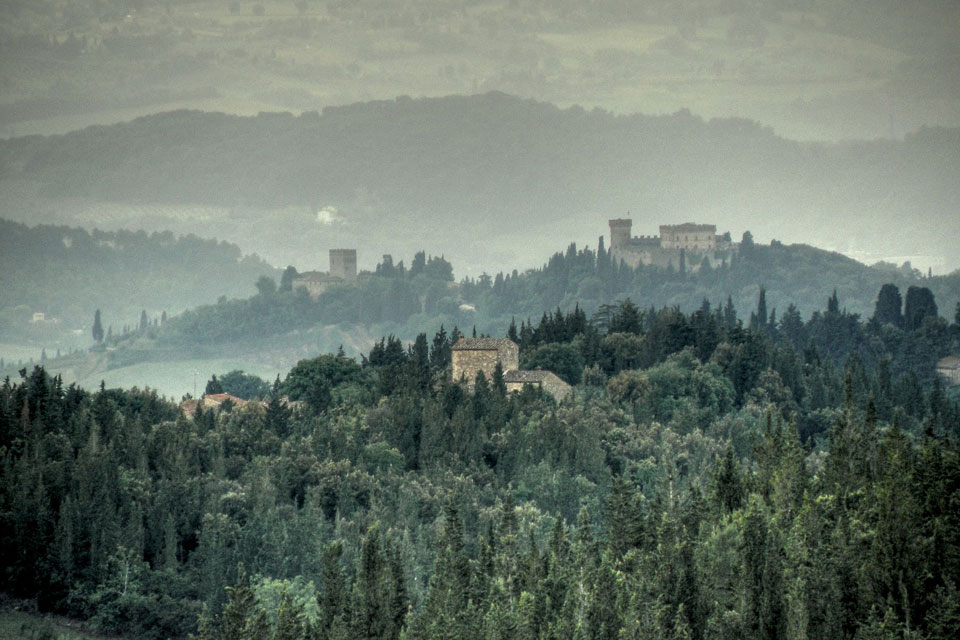Heavily bombarded during WW2, Poggibonsi’s charm resides in the suburbs and a few hidden gems.
Poggibonsi located on the Via Francigena was once a beautiful town with strategic importance. Unfortunately, it was heavily bombarded during WW2, to which should be added its unfortunate location next to the autostrada from Firenze to Siena. Its nickname – the dirty armpit of Tuscany – reveals its traditional reliance on heavy industry. Although it does boast of the odd Gothic Palace – the Palazzo Pretorio – and a Collegiate church with some frescoes by Vincenzo Tamagni, it offers only a few sights in town, which are worth a stop.
History
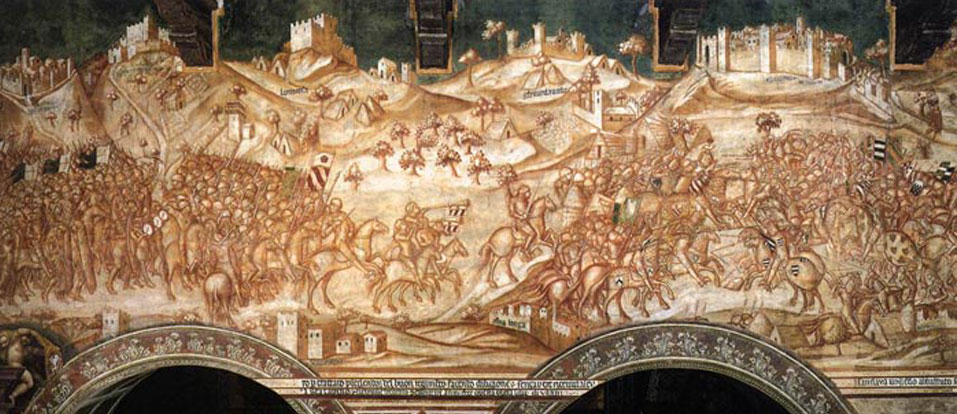
Until the 9th century, Poggibonsi was a hilltop village located to the south of the present city centre. Later, when the Carolingians arrived, a large seigneurial hall was constructed inside this village. Rebuilt as a fortified manor-house, called Borgo di Marte, it is believed that a complimentary proto-town was soon founded further down the slope in the valley. To this, the old Poggiobonizo, people increasingly moved. At the beginning of the 13th century, the Holy Roman Emperor Frederick II declared it for an imperial city. At this time, it was visited several times by St. Francis. Later in the 13th century, the city was laid waste in the civil war between the Florentine Guelphs and the Ghibellines, to be rebuilt once more.
Fortezza di Poggio Imperiale
Finally, in the late 15th century, Lorenzo il Magnifico began construction of a massive castle on the ancient hilltop, called the Poggio Imperiale. Built by Giuliano da Sangallo at the end of the 15th century, only the fortifications are left of a project, what was apparently never brought to an end. Today, a popular site for picnics and excursions, the hilltop has been carefully excavated, revealing the history of the settlement from the 6th to the 16th century.
Archeodromo Poggibonsi
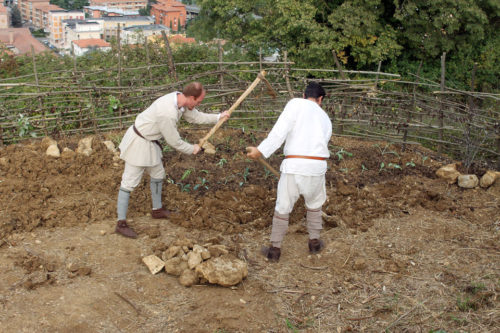 Recently a group of dedicated archaeologists and historians teamed up with the city of Poggibonsi and the Italian Ministry of Culture to create a faithful replica of the Carolingian village with its great hall and more humble peasant huts, which tells the story of life during the time of Charlemagne, his son and grandsons. Peopled by a full role-playing community of re-enactors and living historians, the museum is a faithful recreation of the 9th-century village. The aim is to demonstrate how a collaboration between professional scholars, scientists and living historians can secure an authentic and much more attractive experience than what is offered at the odd medieval market dotting the countryside during summertime. Read the full story about the Archaeological Open-Air Museum in Poggibonsi here.
Recently a group of dedicated archaeologists and historians teamed up with the city of Poggibonsi and the Italian Ministry of Culture to create a faithful replica of the Carolingian village with its great hall and more humble peasant huts, which tells the story of life during the time of Charlemagne, his son and grandsons. Peopled by a full role-playing community of re-enactors and living historians, the museum is a faithful recreation of the 9th-century village. The aim is to demonstrate how a collaboration between professional scholars, scientists and living historians can secure an authentic and much more attractive experience than what is offered at the odd medieval market dotting the countryside during summertime. Read the full story about the Archaeological Open-Air Museum in Poggibonsi here.
Il Santuario del Romituzzo
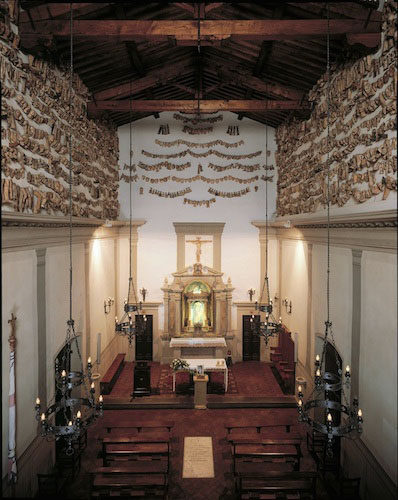
Sometime in the early 14th century, a hermit constructed the Romituzzi Santuary. Later in the 15th century, it was turned into a small shrine, housing a small devotional Madonna, painted by an unknown artist. In the 16th century, the first miracles were reported and the devotion to the site is witnessed by more than 5000 votive papier-mâché figures of arms, legs, hands, feet, heads and any limb imaginable. It does not take much effort to imagine that pilgrims passing up and down the Via Francigena would find their way here depositing all their infirmity and sorrow.
The votive gifts given to Our Lady for her graces, slowly filled the walls of the church, the vestry and the porch. The votive offerings were of various types: silver ones were merged in 1700 to build the lamp hanging from the ceiling, while the votive paintings, executed from the sixteenth to the nineteenth century, are now housed in the sacristy. Prominent, though, are the 5125 anatomical ex voto hanging on the walls of the church. It is likely they were industrially fabricated in the nearby Colle di Val d’Elsa, which had specialized in the paper-industry.
Medieval Inn
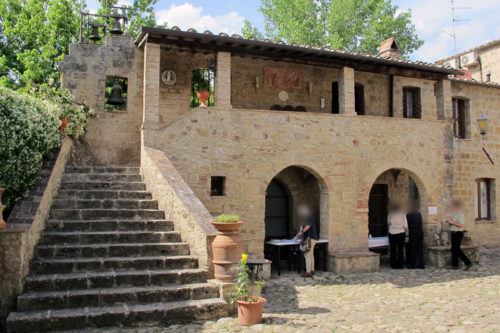
Another site not to be missed is the nearby Castello Della Maggione with the church of San Giovanni al Ponte. Also called the Spedale di San Giovanni in Gerusalemme alla Magione, it is an example of a small mansion, which was run by the Knights Templars as a pilgrimage and hospice. The complex includes the ancient church as well as the old hospice. Located near the ancient crossing of the River Staggia near the Bonizio bridge, it dates to the 11th century. In 1140, the place was donated to the monks of the St. Michel Abbey in Poggio Marturi, who let it to the Templars. Later, after the Templars were suppressed at the beginning of the 14th century, it was turned into a peasant farm. However, in 1979, it was donated to the order of the “Militia Templi”, which has strived to restore the complex to its medieval glory. Castello della Maggione represents one of the best preserved of these “Domi Templari” which catered to the travellers on the Via Francigena. Visitors have the possibility of inspecting the courtyard, the convent, and the small guest rooms. The place is used as headquarters for several offices and enterprises, and can only be visited in the afternoons between 17.00 and 18.30 on weekdays, or on Sunday morning after Mass. The site tells a remarkable story of the pilgrims and Templars and the conditions for travelling in the Middle Ages.
Strozzavolpe Castle
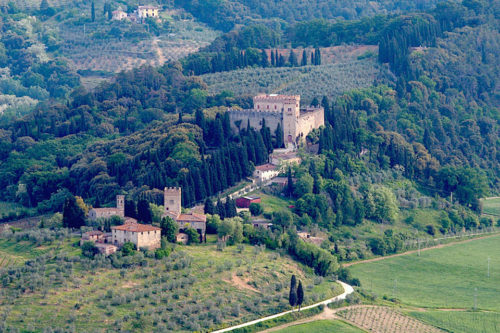
The Strozzavolpe Castle to the east of Poggibonsi is an important fortification, first mentioned in the 12th century, called scoriavolpe. Located to the east of Poggibonsi, it was obviously part of the system of fortifications which ruled over and protected the pilgrims and other travellers on the Via Francigena. The present building complex dates from the 13th and 14th century when the castle was walled and moated. In 1313 it was seized by Henry VII of Luxemburg, who used it as a stronghold to dominate the Sienese countryside. Later, it was sold to a noble from Florence, who transformed it into a liveable manor house. Later, extensive restoration was undertaken in the 19th century
Nevertheless, it still presents itself as one of these impregnable medieval castles, which were painted in a fresco by Francesco D’Andrea and Giovanni di Cristoforo Ghini depicting the Victory of the Sienese over the Florentines at the battle of Poggio Imperiale, 1480 (in the Palazzo Communale in Siena). The castle itself is seldom open for view, but it is possible to stay in apartments located either in the tower of the Lucca, down the slope, or the castle itself. The wine cellars – the Fattoria di Strozzavolpe ¬– are also open for inspection! With its village below, the medieval castle further up the slope, complete with towers and drawbridges, looks like the epiphenomena of a classic Tuscan hilltop village. The landscape is the main attraction.
San Lucchese
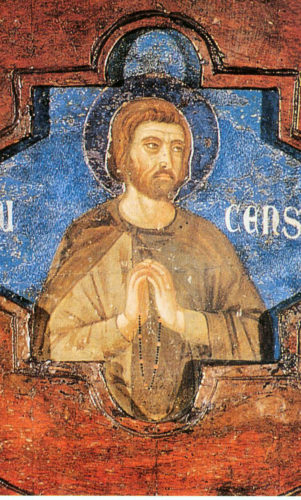
Further to the south-west, a small by-road leads to another of those hidden villages in Tuscany, which gives this particular sense of place. Here at San Lucchese stands an old Romanesque church. Although rebuilt in the 13th century, and again after WW2 it holds some mildly interesting frescoes attributed to Bartolo di Fredi (1330 -1410) and the Master of San Lucchese. The church tells an important part of the history of the Franciscan order. Abandoned in the 12th century, the church was gifted to St. Francis of Assisi in 1220 on his second trip to Poggibonsi, who then handed the church over to the first Franciscan tertiary, St. Lucchese and his wife. Lucchese had met St. Francis for the first time in 1213 and was so inspired by the saint that he gave away all his possessions and lived off alms with his wife. After their death in 1251, the companion of St. Francis and later the leader of the order, Brother Elias, had the church restored. The chapels in the apse were constructed in the 14th century, while the portico stems from the 16th century. It has the title, minor basilica. The main attraction is the curious cupboard in the sacristy from the 14th century with small medallions of saints painted by Memmo Filippuccio. Here is also found a portrait of San Lucchese. However, the frescoes are also worth a scrutiny. As usual, they show delightful details of life in the Medieval Tuscan countryside. Today, San Lucchese is a franciscan convent, which offers the possibility for a spiritually informed stay at Convento basilica di San lucchese frati francescani minori località San lucchese.
SOURCE:
FEATURED PHOTO:
Medieval castles near Poggibonsi. © Tesoro di Siena
